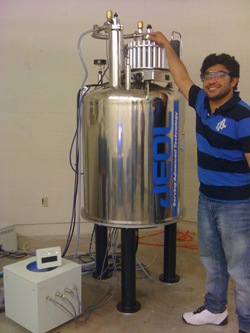New NMR instrument ‘transformative’ for UALR
A new Nuclear Magnetic Resonance (NMR) instrument that could prove “transformative” for the UALR campus was recently installed following approval of a multi-thousand dollar grant from the National Science Foundation.
 Principal Investigator Dr. Anindya Ghosh headed a team of researchers, which submitted and received approval for $273,118 in funding from the foundation.
Principal Investigator Dr. Anindya Ghosh headed a team of researchers, which submitted and received approval for $273,118 in funding from the foundation.
UALR provided a 30 percent mandatory match to make the purchase possible, bringing the combined total funding for the instrument to $390,168.
Campus faculty and graduate students from across several disciplines now have an indispensible tool to study samples at the molecular level, according to Drs. Brian Berry and Darin Jones, two of the co-investigators for the project.
“I’m super excited about the new instrument,” said Jones. “I look at the teaching and research possibilities this instrument provides us and it could be almost transformative.”
Berry agreed, saying the instrument also provides leverage for future grants since it demonstrates that UALR has the appropriate technological and research infrastructure in place for additional funding requests. He said the instrument also will greatly enhance the faculty members’ ability to publish papers and train their students.
“For all of us, the research impact is so significant. Our research cannot progress without the instrument,” he said.
The NMR’s boon to the scientific community is demonstrated by the number of Nobel Prizes awarded since its introduction in the early 1940s.
Its utility stems from the fact that scientists can use its high resolution picture to determine how atoms are connected to form a unique molecular structure. Faculty members from chemistry, biology, applied science, and nanotechnology will find the instrument particularly beneficial for their research.
In addition, faculty at partner institutions–Philander Smith College and The University of Arkansas at Pine Bluff–will have access to the instrument, enhanced by ‘cyber-enabled’ technology that provides a way to do research remotely.
Principal Investigator Ghoush said for the past three to four years, researchers at UALR had to drive to the National Center for Toxicological Research in Jefferson County or send samples to a different university to use such a high-tech instrument, a cumbersome and time-consuming process.
“Now, faculty have easy access to the much-needed instrument, which is centrally located and housed on the first floor of the Engineering Technology and Sciences Building, across from the dean’s office,” Ghosh said.
The instrument will be maintained by the Graduate Institute of Technology.
Co-investigator and Chemistry Chair Jeffrey Gaffney said the research-grade instrument was “absolutely crucial” to further develop College of Science research programs in materials, pharmaceutical synthesis, and environmental science, among others.
“I am extremely proud of my junior faculty in leading the way to this successful instrument acquisition from the National Science Foundation. I expect it will be extremely useful in our teaching and research,” Gaffney added.
“Nuclear Magnetic Resonance spectroscopy is the premier method for determining the structures of organic molecules,” said co-investigator Tito Viswanathan.
“And the presence of a 400-MHz instrument is essential for advanced research,” he said. “I do not know of any chemistry department in the nation that offers a Ph.D. degree that doesn’t have a high field NMR equipment.”
The National Science Foundation grant is providing in-depth training for the instrument’s potential users over the summer months.
Sreevishnu Cheerla, a chemistry graduate student, will be trained to help maintain the instrument as well as perform day-to-day operations. His assistantship will be funded by the College of Science as part of the institutional match.
He was clearly already at home in the instrument’s lab room as he demonstrated how to interpret the results of a sample being analyzed. Others who worked on the project included Steve Grace of the Department of Biology; Julian Post of the Graduate Institute of Technology; Alexandru S. Biris of the College of Information Sciences; Frank Hahn of Philander Smith College; and Richard Walker of UAPB.